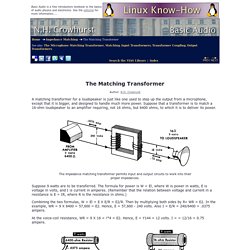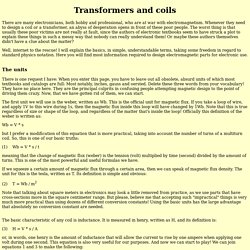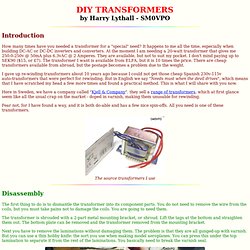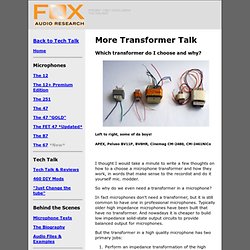

The Matching Transformer. Author: N.H.

Crowhurst A matching transformer for a loudspeaker is just like one used to step up the output from a microphone, except that it is bigger, and designed to handle much more power. Suppose that a transformer is to match a 16-ohm loudspeaker to an amplifier requiring, not 16 ohms, but 6400 ohms, to which it is to deliver its power. Suppose 9 watts are to be transferred. The formula for power is W = El, where W is power in watts, E is voltage in volts, and I is current in amperes. Combining the two formulas, W = El = E X E/R = E2/R. At the voice-coil resistance, WR = 9 X 16 = ! But what would happen if a matching transformer were not used? Notice what the transformer does: it reduces the voltage by the ratio of turns in the windings (called the turns ratio) and it also increases the current by the same ratio.
The high winding must have 20 times as many turns as the low winding. When the voice coil is connected across a 12-volt source, it will draw 0.75 ampere. Ferroxcube - ferrite cores, bobbins & accessories. Catalogs. Practical Transformer Winding. In the good old times it was a matter of fact that every electronic hobbyist or technician would wind himself any power transformers he needed, and rewind any that burned out.

Unfortunately, nowadays transformer winding is fast becoming a lost art, and I have seen many people despair about where to find some very specific transformer, or pull their hair out about the cost of having one professionally wound to specifications. Since I started in electronics, as a 12 year old boy, I have always wound my own transformers. I started using the basic, but useful instructions provided in The Radio Amateur's Handbook of the time, and later I came to better understand how transformers work, which enabled me to optimize a given transformer for the intended application. Following a request by many readers of my web site, I've added this page, which is complementary to the previously published Transformers and coils.
You should first read (and understand!) Let's start with the materials. 1. 2. Coils and transformers. There are many electronicians, both hobby and professional, who are at war with electromagnetism.

Whenever they need to design a coil or a transformer, an abyss of desperation opens in front of these poor people. The worst thing is that usually these poor victims are not really at fault, since the authors of electronic textbooks seem to have struck a plot to explain these things in such a messy way that nobody can really understand them! Or maybe these authors themselves didn't have a clue about the matter? Well, internet to the rescue! I will explain the basics, in simple, understandable terms, taking some freedom in regard to standard physics notation. The units There is one request I have: When you enter this page, you have to leave out all obsolete, absurd units of which most textbooks and catalogs are full: Most notably, inches, gauss and oersted.
DIY TRANSFORMERS. You can make a simple winding tool by cutting a block of wood to fit in the center of the coils, and passing a bolt through the wood.

Use a metal washer or plate at the ends to holes the former in position. Next count the number of turns you get at the chuck when you turn the handle one revolution. I get 51 turns for 13 turns of the handle = 3.92308 turns per revolution of the handle. Amidon™
Products - Custom Magnetics, Inc. Ax_power.PDF - ax_power.pdf. » Audio Transformers. Transformer Talk. Audio transformers are an interesting part of the signal path.

They come from the earliest days of audio technology when there was no other practical way to interface high impedance tube circuits with low impedance input and output devices like microphones and loudspeakers. In the beginning, Electrical Engineers simply wanted the most transparent device they could make to accomplish this impedance transformation. However in the real world of engineering there are always trade-offs to be made. So we see that a transformer's design, core materia, core design and windings all have an impact on the sound. Transfomer manufacturers therefore have to adjust the variables to optimize transfomers for different jobs.
Tube Condenser Microphone output transformers required a a high input to ouput impedance ratio. In this discussion we are going to look three microphone Transformers in actual microphones: Cinemag CM-2480 Peluso BV11P APEX 450 original transformer A Look at Frequency Response Conclusion. Fox Audio Research Home. Which transformer do I choose and why?

Left to right, some of da boys! Transformer Kits Datasheet - Toroid Corporation. Transformer Kits Datasheet - Toroid Corporation. Crimson Audio Transformers. Transformers - Neutrik. Manufacturing Of Voltage Transformer part(1) Iqra University .flv. Crimso Audio Transformers. DIY Resources. - Home Theater Forum and Systems - HomeTheaterShack.com. Frag Jan zuerst- Ask Jan first: Roehren und mehr. EDCOR - XS4400. EDCOR. Peluso Microphone Output Transformers. Budget Phantom powered Ribbon Mic? - Page 2. Budget Phantom powered Ribbon Mic? Mic transformers. JENSEN TRANSFORMERS, INC. - MICROPHONE INPUT TRANSFORMERS.